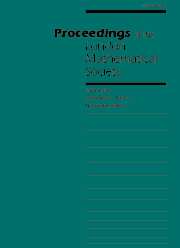Article contents
BIFURCATIONS OF PERIODIC POINTS OF HOLOMORPHIC MAPS FROM [Copf ]2 INTO [Copf ]2
Published online by Cambridge University Press: 01 September 1999
Abstract
Let $F: {\Bbb C}^n \to {\Bbb C}^n$ be a holomorphic map, $F^k$ be the $k$th iterate of $F$, and $p \in {\Bbb C}^n$ be a periodic point of $F$ of period $k$. That is, $F^k(p) = p$, but for any positive integer $j$ with $j < k$, $F^j(p) \ne p$. If $p$ is hyperbolic, namely if $DF^k(p)$ has no eigenvalue of modulus $1$, then it is well known that the dynamical behaviour of $F$ is stable near the periodic orbit $\Gamma = \{p, F(p),\ldots, F^{k-1}(p)\}$. But if $\Gamma$ is not hyperbolic, the dynamical behaviour of $F$ near $\Gamma$ may be very complicated and unstable. In this case, a very interesting bifurcational phenomenon may occur even though $\Gamma$ may be the only periodic orbit in some neighbourhood of $\Gamma$: for given $M \in {\Bbb N}\setminus \{1\}$, there may exist a $C^r$-arc $\{F_t: t\in [0,1]\}$ (where $r \in {\Bbb N}$ or $r = \infty$) in the space ${\Bbb H}({\Bbb C}^n)$ of holomorphic maps from ${\Bbb C}^n$ into ${\Bbb C}^n$, such that $F_0 =F$ and, for $t \in (0,1]$, $F_t$ has an $Mk$-periodic orbit $\Gamma_t$ with $d(\Gamma_t, \Gamma) = \sup_{p \in \Gamma_t}\inf_{q \in \Gamma} \|p - q\| \to 0$ as $t \to 0$. The period thus increases by a factor $M$ under a $C^r$-small perturbation! If such an $F_t$ does exist, then $\Gamma$, as well as $p$, is said to be {\em $M$-tupling bifurcational.} This definition is independent of~$r$.
For the above $F$, there may exist a $C^r$-arc $F^*_t$ in ${\Bbb H}({\Bbb C}^n)$, with $t \in [0,1]$, such that $F^*_0 = F$ and, for $t \in (0,1]$, $F^*_t$ has two distinct $k$-periodic orbits $\Gamma_{t,1}$ and $\Gamma_{t,2}$ with $d(\Gamma_{t,i}, \Gamma) \to 0$ as $t \to 0$ for $i = 1,2$. If such an $F^*_t$ does exist, then $\Gamma$, as well as $p$, is said to be {\em $1$-tupling bifurcational.}
In recent decades, there have been many papers and remarkable results which deal with period doubling bifurcations of periodic orbits of parametrized maps. L. Block and D. Hart pointed out that period $M$-tupling bifurcations cannot occur for $M > 2$ in the 1-dimensional case. There are examples showing that for any $M\in {\Bbb N}$, period $M$-tupling bifurcations can occur in higher-dimensional cases.
An $M$-tupling bifurcational periodic orbit as defined here acts as a critical orbit which leads to period $M$-tupling bifurcations in some parametrized maps. The main result of this paper is the following.
{\sc Theorem.} {\em Let $k \in {\Bbb N}$ and $M \in {\Bbb N}$, and let $F: {\Bbb C}^2 \to {\Bbb C}^2$ be a holomorphic map with $k$-periodic point $p$. Then $p$ is $M$-tupling bifurcational if and only if $DF^k(p)$ has a non-zero periodic point of period $M$.}
1991 Mathematics Subject Classification: 32H50, 58F14.
- Type
- Research Article
- Information
- Proceedings of the London Mathematical Society , Volume 79 , Issue 2 , September 1999 , pp. 353 - 380
- Copyright
- 1999 London Mathematical Society
- 6
- Cited by


